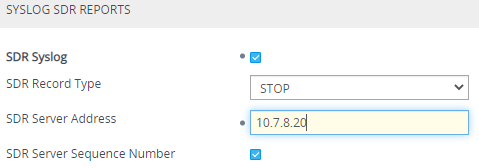Configuring SDR Reporting to Syslog Server
You can enable the device to send SDRs to a syslog server. You can also enable it to add a unique, sequential number "[S=<Number>]" to the syslog message per SDR. The following is an example of a syslog message sent for an SDR generated at the end of a successfully established and terminated call (STOP SDR type) and for a failed call (ATTEMPT SDR type):
18:14:56.981 10.8.5.191 local6.notice [S=1] |RecordType |ProductName |ShelfInfo|SeqNum |SessionId |SetupTime |TimeToConnect |CallDuration|TimeZone|IngressCallingUserName|EgressCallingUserName|IngressDialedUserName| EgressCalledUserName|IngressCallSourceIp |EgressCallDestIp |EgressTrmReason |EgressSIPTrmReason |IngressSipInterfaceName |EgressSipInterfaceName |RouteAttemptNum
18:23:32.319 10.8.5.191 local6.notice [S=2] |ATTEMPT |SBC |48 |5 |20d56a:48:11 |15:34:44.029 UTC Wed Aug 26 2020|0 |-1 |UTC |1000 |1000 |2000 |2000 |10.8.5.91 |10.8.5.92 |RELEASE_BECAUSE_FORWARD |302 |SIPInterface_1 |SIPInterface_2 |0
18:23:36.954 10.8.5.191 local6.notice [S=3] |STOP |SBC_SDR_Test |48 |6 |20d56a:48:12 |15:34:44.126 UTC Wed Aug 26 2020|260 |198 |UTC |1000 |1000 |2001 |2001 |10.8.5.91 |10.8.5.92 |GWAPP_NORMAL_CALL_CLEAR |BYE |SIPInterface_1 |SIPInterface_2 |0
|
●
|
The SDR sequence number starts from 1 and is incremented by 1 for each STOP, ATTEMPT and INTERMEDIATE SDR that is generated by the device. |
|
●
|
For a call setup in which the egress side sends a SIP failure response code (e.g., 4xx or 5xx) that triggered the device to use an alternative route for the call, the device generates an ATTEMPT SDR. After the connected (re-routed) call terminates, the device generates a STOP SDR. |
|
●
|
For a call setup in which the egress side sends a SIP 3xx response, the device generates an ATTEMPT SDR.
After the connected call has terminated, the device generates a STOP SDR.
|
|
●
|
For a forking call scenario, the device generates an ATTEMPT SDR for each forked leg that responds with failure or is terminated by the device after one of the legs accepted the call. The device also generates one STOP SDR for the forked leg that accepted the call. |
|
●
|
You can customize the fields that are included in the SDR. For more information, see Customizing SDR Fields. |
|
➢
|
To configure SDR reporting to syslog server: |
|
1.
|
Open the Session Detail Record Settings page (Troubleshoot menu > Troubleshoot tab > Session Detail Record folder > Session Detail Record Settings), and then scroll down to the Syslog SDR Reports group: |

|
2.
|
Select the 'SDR Syslog' check box to enable the device to send SDRs to a syslog server. |
|
3.
|
From the 'SDR Record Type' drop-down list, select the SDR type(s) that you want generated: STOP, ATTEMPT and STOP, ATTEMPT INTERMEDIATE and STOP, or INTERMEDIATE and STOP: |
|
●
|
"STOP" SDRs are generated for successfully established and terminated calls. These SDRs are generated when the call ends. |
|
●
|
"ATTEMPT" SDRs are generated for failed call attempts and . These SDRs are generated when the call attempt process ends. |
|
●
|
"INTERMEDIATE" SDRs are generated during an established call. You can configure when during the call to generate the first SDR and the interval between each subsequently generated SDR. |
|
4.
|
If you configured the 'SDR Record Type' parameter (above) to an option that includes INTERMEDIATE, you also need to configure the intervals for INTERMEDIATE SDRs (see Configuring Intervals for Intermediate SDRs). |
|
5.
|
In the 'SDR Server Address' field, configure the address (IPv4 or IPv6 address, or FQDN) of the syslog server for SDRs. |
|
6.
|
Select the 'SDR Server Sequence Number' check box to include a sequence number for the SDRs in the sent syslog message. The sequence number is incremented for each SDR record. |
